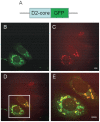Fluorescence lifetime imaging of alterations to cellular metabolism by domain 2 of the hepatitis C virus core protein
- PMID: 23826122
- PMCID: PMC3691201
- DOI: 10.1371/journal.pone.0066738
Fluorescence lifetime imaging of alterations to cellular metabolism by domain 2 of the hepatitis C virus core protein
Abstract
Hepatitis C virus (HCV) co-opts hepatic lipid pathways to facilitate its pathogenesis. The virus alters cellular lipid biosynthesis and trafficking, and causes an accumulation of lipid droplets (LDs) that gives rise to hepatic steatosis. Little is known about how these changes are controlled at the molecular level, and how they are related to the underlying metabolic states of the infected cell. The HCV core protein has previously been shown to independently induce alterations in hepatic lipid homeostasis. Herein, we demonstrate, using coherent anti-Stokes Raman scattering (CARS) microscopy, that expression of domain 2 of the HCV core protein (D2) fused to GFP is sufficient to induce an accumulation of larger lipid droplets (LDs) in the perinuclear region. Additionally, we performed fluorescence lifetime imaging of endogenous reduced nicotinamide adenine dinucleotides [NAD(P)H], a key coenzyme in cellular metabolic processes, to monitor changes in the cofactor's abundance and conformational state in D2-GFP transfected cells. When expressed in Huh-7 human hepatoma cells, we observed that the D2-GFP induced accumulation of LDs correlated with an increase in total NAD(P)H fluorescence and an increase in the ratio of free to bound NAD(P)H. This is consistent with an approximate 10 fold increase in cellular NAD(P)H levels. Furthermore, the lifetimes of bound and free NAD(P)H were both significantly reduced--indicating viral protein-induced alterations in the cofactors' binding and microenvironment. Interestingly, the D2-expressing cells showed a more diffuse localization of NAD(P)H fluorescence signal, consistent with an accumulation of the co-factor outside the mitochondria. These observations suggest that HCV causes a shift of metabolic control away from the use of the coenzyme in mitochondrial electron transport and towards glycolysis, lipid biosynthesis, and building of new biomass. Overall, our findings demonstrate that HCV induced alterations in hepatic metabolism is tightly linked to alterations in NAD(P)H functional states.
Conflict of interest statement
Figures





References
-
- Crespo G, Marino Z, Navasa M, Forns X (2012) Viral hepatitis in liver transplantation. Gastroenterology 142: 1373–1383 e1371. - PubMed
-
- Hoofnagle JH (2002) Course and outcome of hepatitis C. Hepatology. 36: s21–s29. - PubMed
-
- Lindenbach BD, Rice CM (2005) Unravelling hepatitis C virus replication from genome to function. Nature 436: 933–938. - PubMed
-
- Assis DN, Lim JK (2012) New Pharmacotherapy for Hepatitis C. Clin Pharmacol Ther. 92: 294–305. - PubMed
Publication types
MeSH terms
Substances
Grants and funding
LinkOut - more resources
Full Text Sources
Other Literature Sources

